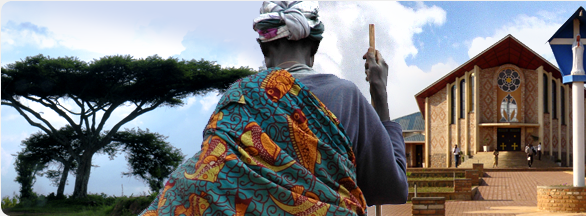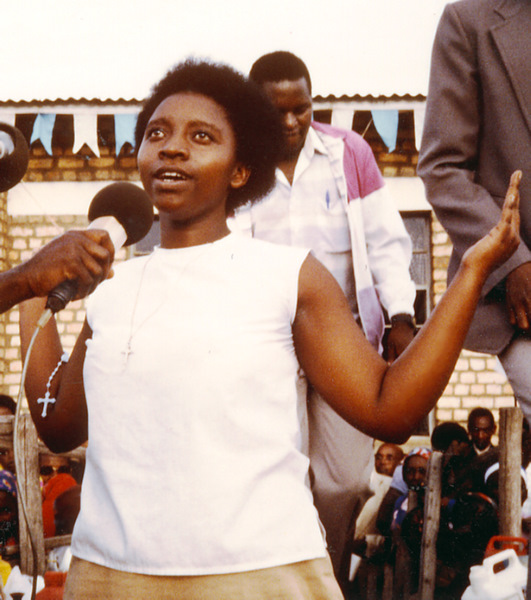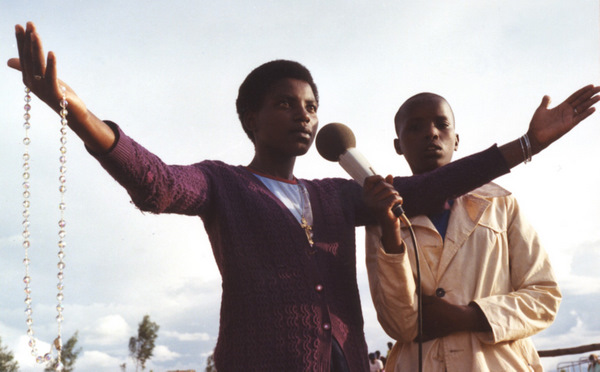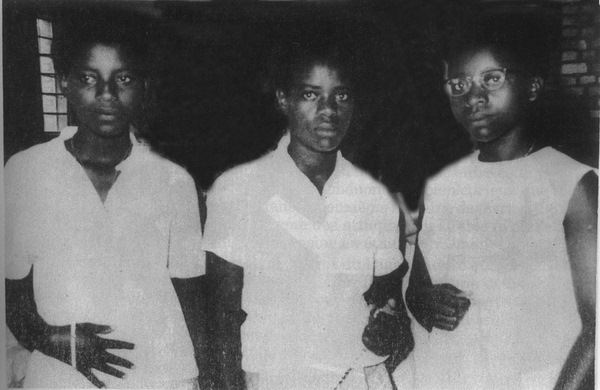Apparitions of the Blessed Virgin Mary at Kibeho – brief overview

If the parish of Kibeho is being spoken of as a place of pilgrimage and apparitions, it is due to the fact that, on November 28th, 1981, a young student of the College of Kibeho, called Alphonsine Mumureke, claimed to see a Lady of incomparable beauty who presented herself as "Nyina wa Jambo", i.e. the "Mother of the Word", immediately recognised by the supposed visionary as the Blessed Virgin Mary, mother of Jesus our Saviour. The phenomenon subsequently repeated itself spaced at longer or shorter intervals.

The first reactions created by these unusual events within the community of the College as well as outside were not tender at all. There were a variety of positions ranging from skepticism to a more or less enthusiasm that might lead to credulousness and intolerance. They first assumed Alphonsine to be crazy, to be either an unfortunate girl possessed by evil spirits or a poor student who simply wants to act up in order to be more appreciated in the school run by the Benebikira Sisters.
Voices were being raised claiming signs of credibility. When Alphonsine was in trance, all students and professors who wanted, had the freedom to carry out tests on Alphonsine's body in order to put her to the test and thus prove her sincerity.
Some even said, that they were ready to believe that the Blessed Virgin had decided to visit them, if she would show herself to others rather than to pitiful Alphonsine, who came from Gisaka region, popular for it's cunning magic. Alphonsine prayed a lot to Our Lady, asking her to hear her and appear to others as well. She also urged her companions at school to ask the Blessed Virgin for enlightenment.
Some time later, two new visionaries turned up at the College one after another, in conformance with Alphonsine: Nathalie Mukamazimpaka, from January 12th, 1982 and Marie Claire Mukangango, from March 2nd, 1982. For some people, the increased number of visionaries complicated the already difficult situation created by Alphonsine even more. Others interpreted the two new cases in general and Marie Claire's testimony in particular as a sign from heaven that Alphonsine's prayers had been answered, which should increase faith in those still reluctant to the apparitions that Alphonsine was favoured by. Various witnesses interviewed at Kibeho College in the year 1982, reported that they started to believe due to the extraordinary experience of Marie Claire.
In short, the public did everything to find a natural explanation of the phenomenon, but without much success, given a set of astonishing events beyond the simple human understanding. Despite criticism and objections against the apparitions, a movement of devotees began to develop quite rapidly inside as well as outside the College of Kibeho. Already before the Christmas holidays in 1981, a group of students and “converted” professors assiduously joined the prayer meetings with Alphonsine, where they recited the rosary interlacing canticles in honour of the Blessed Virgin.
From the month of May 1982, this phenomenon disspread outside the microcosmos of the College of Kibeho like a bush fire, reaching the surrounding hills and even the most rural areas.
What is striking is that the number of visionaries within the College stopped at the number of three without the intervention of any external authority. On the contrary, the number of people outside the College claiming to be visionaries continued growing in a rather fast and troublesome way. From July 1982, about seven months after the beginning of the apparitions of the Virgin Mary, rumours abounded about people having seen apparitions of Jesus. As time passed, however, the suspected visionaries of Jesus, prominent among the pilgrims coming to Kibeho, developed a rather disturbing way of promoting their visions.
Another point to consider is that during the days of public apparitions, there were no group ecstasies at all, neither visionaries having apparitions at the same time. On the contrary, the visionaries took turns having individual apparitions, either by exchanging positions, or by benefitting alone of a "Celeste visit" almost exclusively while others were to attend like everyone else. The apparitions were generally marked by the fainting of the visionaries, who used to heavily hit the ground, especially at the end of an ecstasy.
The various apparitions were distinguished by their abundance of words, by the length of the ecstasies, by the songs and prayers of intercession used during the apparition, by the blessings given (especially with holy water), by the repeated fainting in one and the same apparition at some days (as from August 15th, 1982 until the end of Lenten Season in 1983) and by self-mortification; especially the Lenten Season of 1983 was marked by extraordinary fasting, closely followed by a team of doctors from the National University of Rwanda.

On March 20th, 1982, Alphonsine Mumureke said to have made a "mystical journey" with the Virgin Mary for several hours travelling through places which they described in a symbolic language, reminding us of realities such as hell, purgatory and heaven, but using vocabulary different from that of the catechism. Nathalie Mukamazimpaka had a similar experience on 30th October 1982, closely followed by a team of the theological commission.
News about the apparitions of Kibeho spread very fast and attracted people from the whole world. At some days, such as May 31st and August 15th, 1982, the number of visitors reached more than 10.000 people of different age and social status. Not all of them were pilgrims who came for reasons of faith and piety, some travelled to Kibeho out of pure curiosity and in expectation of interesting things to see. Gradually, however, the situation relaxed.
The significant time of the apparitions ended with the year 1983, when two of the supposed visionaries of Kibeho left the podium one after another, declaring that the apparitions had finished for them. This was except for Alphonsine, the rarefaction of whose apparitions became evident already before November 1982.
From 1984 on, a few so-called “secondary visionaries” had public apparitions at spaced intervals, mostly on stereotypical dates, but without any original supplements to the message of Kibeho.
The apparitions of Kibeho officially ended on, exactly eight years after the very first apparition, when Alphonsine, the “origin” of all events, had her last apparition of the Virgin Mary in public. She stated that she would now no longer have any public apparitions. Thus, November 28th, 1989 is a historic date in the case of the apparitions of Kibeho and was announced official end of these phenomena by the church authorities.
The duration of the apparitions of Kibeho was remarkably long. Many words were said, and many mysterious things revealed over the years.The phenomenon of the proliferation of people claiming to be visionaries, however, continued to spread within the area of Kibeho and all across the country, misleading many pilgrims as well as persons responsible for the monitoring of these events. Thus, the number of supposed visionaries listed in the file of the commissions of inquiry reached 14 on November 28th, 1982, one year after the forst apparitions; on November 28th, 1983 they were 33 – all of them girls. Some claimed to have seen Virgin Mary, others wanted to have seen Jesus; still others said they saw the Virgin Mary on one day and Jesus on another day. In short: The situation started to become complicated.
Well-intentioned credulousness and an excess of respect for the religiousness of people appear to have contributed in one way or another to the proliferation of “pretenders”. There were even cases of people frequenting certain parts of the country to spread the so-called celestial messages, without the accord of the competent ecclesiastical authority. They left their own families to get hosted in convents and other religious communities. From there they went to harass the civil and religious authorities with the messages they pretended to have received from heaven; from time to time they presented themselves at Kibeho. Many people were troubled by these messages, consisting of simple banalities or troubling and confusing predictions.

Some of these “visionaries” said to have been given a special mission by Jesus and the Virgin Mary to proclaim their message abroad – especially in the neighbouring countries, but also in Europe or in North America, more specifically in Canada. On this issue, my predecessor, Mons. Gahamanyi, Bishop of the Diocese of Butare, which Kibeho belonged to until 1992, specified already in his pastoral letter of July 30th, 1986, that, since the case of Kibeho was under investigation, he, as the local ordinary, was in no way going to neither entrust any mission related to these events to any visionaries of any kind, nor would he approve of any messages which these visionaries would say to have received from heaven, even if some of the contents “are good and touch the hearts of people".
With this, the local ordinary aimed at the cases of the improvised visionary "missionaries" and itinerant preachers. Mons. Augustin Misago, Bishop of Gikongoro since 1992, advanced the same view later on and it will remain valid forever.
At a number of occasions, the local ordinary appealed to the common sense of the Christians and to their communion sense of faith, asking them to question with discernment each and every person claiming to have supernatural visions or to carry a particular message coming from heaven. A number of pilgrims coming to Kibeho started to learn, step by step, to discern the visionaries who, in their eyes, deserved to be listened to more carefully from a whole lot of others, who, on the contrary, seemed suspect or even false to various degrees.
Investigation commissions
Mons. Jean Baptiste Gahamanyi, Bishop of the Diocese of Butare to which Kibeho belonged at the time when the apparitions began, did his best to carefully investigate the situation in Kibeho in order to be able to make a judgement on it. Thus, two separate investigation commissions were soon established by the local ordinary: a medical commission, installed on March 20th, 1982 and a theological commission, installed on May 14th, 1982. These commissions, each following its own methods, started to work soon after, with much effort and a great dedication, investigating the events in all objectivity, patience, serenity and without putting into account their personal emotions. Fulfilling their duty, they were guided by instructions given by the Holy See: The "Norms for Judging Alleged Apparitions and Revelations", published by the Congregation of the Doctrine of Faith on February 24th, 1978 in Rome.
However, given the large number of the supposed visionaries, who had never had apparitions in a group and thus had to be investigated one by one, the commissions had to create methods of more efficiency in order to get on with their work. Thus, they gave priority to the first eight supposed visionaries: Those of the first year of the apparitions at Kibeho, i.e. between November 28th, 1981 and November 28th, 1982. This choice, however, was a working hypothesis, not a presumption of authenticity for such a large number of visionaries.
The investigation commissions produced numerous reports, presented to the authorities. In his pastoral letters on the events of Kibeho, my predecessor, Mons. Jean Baptiste Gahamanyi, briefly mentions the work accomplished as the investigations progressed. We are going to come back to this point in the next chapter.
On March 30th, 1992, the Diocese of Butare was divided into two. Thus, the Diocese of Gikongoro was established and entrusted to Mons. Augustin Misago, member of the theological commission for the apparitions of Kibeho at that time. The dossier of the investigation commissions was going to depend on this young diocese. It was however agreed that both the medical and theological commission should continue their work on behalf of the new diocese, with the theological commission to be updated and reinforced. There was no need for new commissions to be created.
Authorization and promotion of the public worship at Kibeho
The various provisional reports of the investigation commissions submitted to the local Bishop enabled him to make a balanced judgment on this sensitive issue without any precipitation.
It is precisely in the light of the relevant conclusions of these reports, that he thought it to be suitable to formally approve of public worship at the site of the apparitions at Kibeho. This important event took place on August 15th, 1988 at the solemnity of the Assumption of Mary, on the occasion of the closing of the Marian year proclaimed by Pope John Paul II in his Encyclical "Redemptoris Mater" (March 25th, 1987).
Ever since we are able to receive the Holy Eucharist and all other sacraments of the Church at the place of the apparitions and thus legitimately manifest our faith in relation to these events. However, the local ordinary needed to precise that allowing this devotion must not be confused with an eventually possible "recognition of the supernatural character of the apparitions at this site”. This implicates that none of the visionaries of Kibeho had been officially approved by that time.
The Church thus proceeded to examine the events with minuteness, rather reluctant about the recognition of the authenticity of the apparitions; ensuring, at the same time, that the spiritual fruit which already grew in Kibeho, were being protected by public worship.
The formal approval of the the worship at the site of the apparitions in Kibeho proved, among other aspects, that the “sensus fidei” and the "vox populi" had not got lost.
The Bishop of Gikongoro, Mons. Augustin Misago, who became ipso facto the local ordinary responsible for the site of the apparitions, I took the commitment to continue the examination of the dossier of the apparitions by walking in the footsteps of his predecessor, Mons. Jean Baptiste Gahamanyi, but trying to get the Episcopal Conference of Rwanda more involved. In order to promote the public worship already authorised, Mons. Misago presided over the ceremony of laying the foundation stone of the future chapel of the apparitions on the esplanade of the shrine at the first anniversary of the first apparitions, on November 28th, 1992. The same day, the creation of a "pastoral committee for the shrine of Kibeho", its structure and its specific tasks were officially announced.
On May 31st, 1993, the very first official Diocesan pilgrimage to Kibeho was proceeded, led by the Bishop with the intention to pray for peace in Rwanda,. On November 20th, 1993, about one year after the laying of the first stone for the Shrine of Kibeho, the Bishop blessed and inaugurated a provisional Chapel in one of the dormitories of Kibeho secondary school, nicknamed the "dormitory of the apparitions”. Renovated in 2007, this dormitory has been transformed into a chapel and is now known as the "Chapel of the apparitions”.
In 1994 and the years after, the peoples of Rwanda experienced a tragedy beyond comparison in the Tutsi-genocide. Even the visionaries of Kibeho were not spared. Twice, Kibeho was scene of a massive massacre, where helpless civilians where regularly slaughtered just because of their ethnic or political affiliation: In April 1994, in Kibeho parish church and a year later, in April 1995, on the esplanade, where the apparitions had taken place, when people robed of their homes took refuge in Kibeho.
This double human tragedy left deep wounds in the hearts of the survivors.
After rather complicated negotiations with the authorities in charge, it was finally possible to proceed to the ritual of purification of the Shrine of Kibeho and to a gradual restart of the pilgrimages from Christmas Eve 1995 on.




